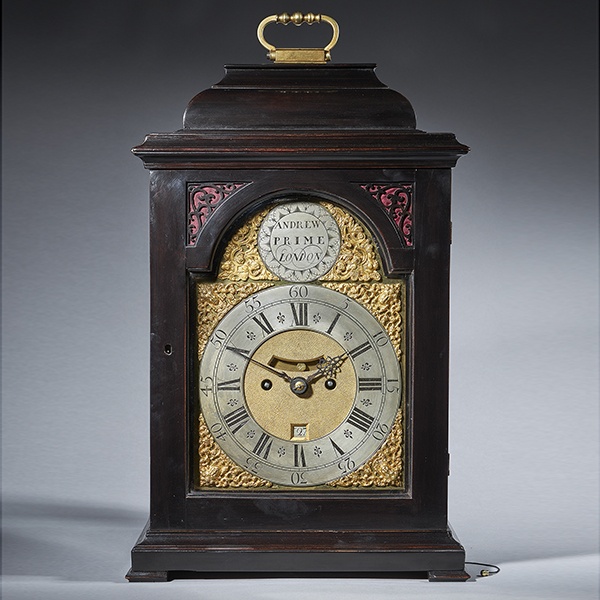17th Century William and Mary Floral Marquetry Olive Oyster Lace Box, Circa 1680
Sold
Request Information
Follow Us
17th Century William and Mary Floral Marquetry Olive Oyster Lace Box, Circa 1680
A fine and rare 17th century William and Mary olive oyster marquetry lace box, circa 1670-1690. England
The ovolo-moulded and holly banded top is centred by an oval of marquetry depicting spring flowers bordered in oysters of olive finely strung to each side and quartered in a similar fashion, all on a ground of ebony.
The frieze is decorated to the face and each side with fine oval reserves of marquetry, and olive oyster veneered, raised on a cross-grain olive convex moulding.
The box opens to reveal what appears to be the original mercury mirror plate in the original frame bordered in a silvered braid and lined in silk.
It should be noted that very few fine marquetry lace boxes from the 17th century are known and this example is particularly accomplished in all aspects.
Condition
Good. Wear consistent with age and use. Superb original condition. The box is of very good colour and is richly patinated.
Dimensions
Height: 4.93 in. (12.5 cm)
Width: 21.26 in. (54 cm)
Depth: 16.15 in. (41 cm)
Literature
The box relates to a marquetry table housed in Levens Hall that was probably supplied by the London cabinet maker Thomas Pistor to James Graham, a friend and courtier to James, Duke of York (later James II). in 1684. Adam Bowett ‘English Furniture 1669-1714, From Charles II to Queen Anne’. Plate 4:20, Page: 116.
Percy MacQuoid ‘A History of English Furniture’ pl. 269, pg. 126
The Victoria and Albert Museum – Accession Number: W.51-1925.
PREVIOUSLY SOLD
No Results Found
The page you requested could not be found. Try refining your search, or use the navigation above to locate the post.
No Results Found
The page you requested could not be found. Try refining your search, or use the navigation above to locate the post.
YOU MAY ALSO LIKE

Fine George III 18th Century Period Mahogany Longcase Clock by Tomas Fowle
18th Century Period Mahogany Longcase Clock by Tomas Fowle £12,995 Follow Us18th Century Period Mahogany Longcase Clock by Tomas Fowle A fine George III period mahogany longcase clock of excellent colour, patination and proportions, circa...

Fine Ebonized George II Eight Day Table Clock with Dutch Striking and Trip Rep
Fine Ebonized George II Eight Day Table Clock with Dutch Striking and Trip Rep £14,900 Follow UsFine Ebonized George II Eight Day Table Clock with Dutch Striking and Trip Rep By the highly regarded maker Andrew Prime. Andrew Prime, was...

17th Century Figured Walnut and Seaweed Marquetry Lace Box
17th Century Figured Walnut and Seaweed Marquetry Lace Box £3,600 Follow Us17th Century Figured Walnut and Seaweed Marquetry Lace Box A fine and extremely rare figured walnut and seaweed marquetry 'lace box', circa.... let’s break it down -...

19th Century Repeating Gilt-Brass Carriage Clock by the Famous Drocourt
19th Century Repeating Gilt-Brass Carriage Clock by the Famous Drocourt £5,600 Follow Us19th Century Repeating Gilt-Brass Carriage Clock by the Famous Drocourt A superb repeating carriage clock with a gilt-brass gorge case by the famous maker...

17th-Century Hague Clock Signed by Pieter Visbagh, circa 1675
Small 17th Century Hague clock made c. 1675 by Pieter Visbagh, who was apprenticed by Salomon Coster. The latter made the first pendulum clock according to the instructions of Christiaan Huygens, the internationally renowned scientist who developed the idea of applying a pendulum to a clock movement.

Pair of 18th-Century English Rococo Gilt Bronze Andirons or Firedogs
An exceptional pair of 18th century English Rococo gilt bronze andirons or fire dogs.
The bold shape of these andirons relate to designs of Thomas Johnson (1714–1778), one of London’s pioneers of the ‘Modern’ or French style, later known as Rococo.

Fine George III 18th Century Period Mahogany Longcase Clock by Tomas Fowle
18th Century Period Mahogany Longcase Clock by Tomas Fowle £12,995 Follow Us18th Century Period Mahogany Longcase Clock by Tomas Fowle A fine George III period mahogany longcase clock of excellent colour, patination and proportions, circa...

Fine Ebonized George II Eight Day Table Clock with Dutch Striking and Trip Rep
Fine Ebonized George II Eight Day Table Clock with Dutch Striking and Trip Rep £14,900 Follow UsFine Ebonized George II Eight Day Table Clock with Dutch Striking and Trip Rep By the highly regarded maker Andrew Prime. Andrew Prime, was...

17th Century Figured Walnut and Seaweed Marquetry Lace Box
17th Century Figured Walnut and Seaweed Marquetry Lace Box £3,600 Follow Us17th Century Figured Walnut and Seaweed Marquetry Lace Box A fine and extremely rare figured walnut and seaweed marquetry 'lace box', circa.... let’s break it down -...

19th Century Repeating Gilt-Brass Carriage Clock by the Famous Drocourt
19th Century Repeating Gilt-Brass Carriage Clock by the Famous Drocourt £5,600 Follow Us19th Century Repeating Gilt-Brass Carriage Clock by the Famous Drocourt A superb repeating carriage clock with a gilt-brass gorge case by the famous maker...

17th-Century Hague Clock Signed by Pieter Visbagh, circa 1675
Small 17th Century Hague clock made c. 1675 by Pieter Visbagh, who was apprenticed by Salomon Coster. The latter made the first pendulum clock according to the instructions of Christiaan Huygens, the internationally renowned scientist who developed the idea of applying a pendulum to a clock movement.

Pair of 18th-Century English Rococo Gilt Bronze Andirons or Firedogs
An exceptional pair of 18th century English Rococo gilt bronze andirons or fire dogs.
The bold shape of these andirons relate to designs of Thomas Johnson (1714–1778), one of London’s pioneers of the ‘Modern’ or French style, later known as Rococo.








